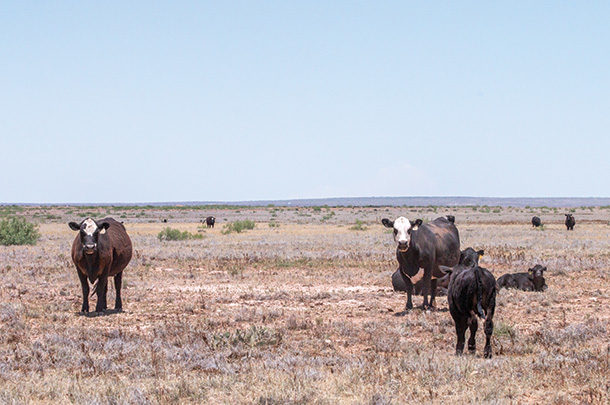With drought plaguing much of the West, producers may have to adjust their management and use creative thinking to maintain production in spring- and fall-calving herds. Continued drought in the West is forcing beef producers to seek ways to minimize feed inputs while maintaining cow numbers. The prediction for summer and early fall is continued or increasing drought in most of the West. Range, pasture, hay and stock water are all short this year.
Strategies differ for spring- and fall-calving operations. Spring-calving operations need to consider focusing on maintaining productive cows, increasing body condition in remaining cows, finding alternatives for heifer development and reducing feed needs. Fall-calving herds’ focus should be on nutrition of lactating cows, increasing body condition on cows, developing plans for marketing calves and reducing feed needs.
Body condition of cows
Body condition is critical for both spring- and fall-calving cows. Spring- and fall-calving cows may come into fall with lower body condition scores (BCS) than normal due to poor pasture and range conditions. Considerable research indicates that cows need to calve in BCS 5 (BCS 1 = extremely thin; BCS 9 = obese). Cows in good body condition also have more vigorous calves and may produce higher antibody concentrations in colostrum. Spring-calving cows need to regain body condition by 45 days before calving, so they will calve in BCS 5. Ranchers should work with extension professionals or consulting nutritionists to develop cost-effective feeding strategies this winter.
This could be an unusual calving season for fall-calving herds. Ordinarily, fall-calving cows calve in BCS 5 to 7 and have little problem breeding back. Fall forage, pasture or hay aftermath often supply all the nutrient needs of fall-calving cows through breeding. Fall-calving cows should be body condition scored before or at calving, and feeding strategies should be developed based on BCS and available feeds.
Early pregnancy diagnosis important during drought
An important drought-management strategy is early pregnancy diagnosis. Fall-calving herds should employ early pregnancy diagnosis, while spring-calving herds should consider pregnancy testing cows 30 to 60 days earlier than normal. This year, strong consideration should be given to marketing late-calving cows as well. Reducing pressure on pastures and feed supplies will improve pasture quality and reserve feed for the most productive cows.
Within 30 to 45 days of the end of the breeding season, veterinarians can diagnose pregnancy in the herd. Veterinarians skilled in the use of ultrasound can diagnose pregnancies as early as 25 to 28 days post-breeding. The cost of pregnancy diagnosis will vary according to veterinarian, distance to the ranch and number of cattle to be checked. Usually, the cost is $4 to $12 per cow, with ultrasound diagnosis being the most expensive. Blood tests for pregnancy, which can detect pregnancy by 25 to 29 days, are also available from several companies. Combining pregnancy diagnosis with other routine herd health procedures can spread the cost of a farm call over more head, reducing the cost per animal.
Early weaning an option for spring- and fall-calving herds
Calves can be weaned from cows as early as 90 to 100 days old. However, early weaning at 150 days is more common, and older calves are already ruminating and are easier to feed. Early weaning will improve calf growth and cow condition during drought. Calves can be reared on remaining pasture with supplementation of byproducts or fed in drylot. This allows cows to be maintained on poor-quality pasture, crop residues or limit feeding byproducts in drylot.
Research from Kansas State indicated that pasture available for calves was increased by 0.4 grazing days for each day a calf was weaned earlier than normal. This indicates that pasture or hay aftermath can be “stretched” and supply more grazing for calves. Calves in this study were weaned at 153 days and fed or grazed for 56 days. As expected, early weaned calves that received no additional supplementation while on pasture weighed 60 pounds less than their normal-weaned contemporaries at the end of the 56 days. In contrast, calves reared in drylot with special diets weighed 50 pounds more than normal-weaned calves. Therefore, diet and supplementation are extremely important for early weaned calves. In addition, retaining ownership on early weaned calves through backgrounding to capture additional value should be considered.
Preparation for early weaning is essential. Calves need to be well vaccinated before weaning. Consult with your veterinarian on vaccination programs for early weaning. Beef producers should plan where calves will be located for early weaning, as well as obtaining feeds for these young calves. Remember, conventional water troughs may be too tall for small calves. Troughs will either need to be shorter or kept brim full at all times. Similarly, automatic waterers will need to have covers or balls removed from drinking holes. Small calves may not be strong enough to push covers/balls down to obtain water. For assistance with early weaning diets for calves, contact your local extension professional or consulting nutritionist.
Spring-calving herds need to consider weaning calves by September, if they are still nursing their dams. Weaning 30 to 60 days early can result in improvements in cow body condition and decrease winter feed needs for pregnant cows.
Reducing feed needs
The strategies already discussed will help reduce feed required for the herd. This year, consider alternatives to normal replacement-heifer development. It may be better to sell all heifer calves this year and source bred replacement heifers as needed. Alternatively, development of replacement heifers could be outsourced to producers in the Midwest and East.
Ranchers should take and analyze forage samples so the amount of nutrients available, not just pounds of hay or silage, are known. Specific diets should be developed for each class of cattle on the operation. Seek help from nutritionists and extensions to develop diets for cattle. Consider alternative feeds such as byproducts, ammoniated straw and crop residues. Before using alternative feeds, producers need to price feeds on cost per pound of protein or energy, not just cost per ton as fed. Some alternative feeds may contain large amounts of water (i.e., cull potatoes or sugarbeets) or be low in nutrient content (i.e., cotton byproducts and stalk bales). As a nutritional source, some feeds that cost more per ton but are higher in nutrition may be a better buy than some alternative feeds.
Getting through the drought will require new management strategies and creative thinking. The earlier decisions are made, the more options will be available. Ranchers are encouraged to seek consultation on cattle diets and marketing decisions.











